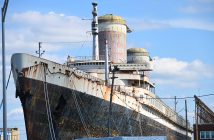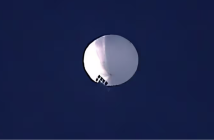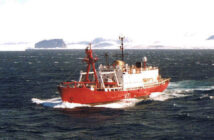Last week, after more than five decades of service during which she became the US Navy’s most iconic and revered warship, the USS Enterprise was decommissioned.
It was the Big E’s uniqueness is what made her so special.
She was the first nuclear-powered aircraft carrier, developing capabilities that differentiate US military power from all others. She had eight reactors and four rudders while other ships had two.
She was eighth Enterprise since 1775, named for the first carrier to bear the legendary name that earned 20 battle starts by participating in more major actions against Japan than any other US warship during World War II. Indeed, in her guts are components built during that war for Montana-class battleships that were never finished.
Indeed, she was the last carrier named for its historic predecessors rather than a person. And the only one to have inspired the greatest fictional starship of all time, Gene Rodenberry’s USS Enterprise.
Enterprise was to have been the first of a class of six new supercarriers, but soaring costs made her an orphan. Two of her successors, the America and John F. Kennedy were oil-fired as the far simpler workhorse Nimitz-class was developed.
Her longevity is due to three factors. First, as the first nuclear carrier, she was overbuilt. Second, she was built at a time when components were made of high quality steel, bronze and brass. Third, as the sole ship in her class, her crew became expert at keeping her and her unique systems at the highest state of readiness throughout her career. It didn’t hurt to have the largest machine shop in the fleet that could, literally, produce large, high-precision machine components overnight.
Authorized during the Eisenhower administration, the keel of America’s first nuclear powered aircraft carrier was laid on Feb. 4, 1958, in Dry Dock 11 at Newport News Shipbuilding.
Although revolutionary, she was built and commissioned in less than four years.
Everything about her was record setting. She displaced 93,000 tons and at 1,123 feet, she remains the longest warship ever built. Her characteristic silhouette was punctuated by a unique square island shaped by the SCANFAR radar system with high-power arrays on each side of the island, capped with a phased array “beehive” on top that were removed in 1980 and replaced by conventional rotating radars that were far less power hungry. The island, however, remained square, producing unique turbulence that made landing on Big E just a bit more challenging for generations of naval aviators.
But her most important attribute were her eight A2W nuclear reactors and 32 steam generators that drove four massive engines generating nearly 300,000 horsepower. Designers decided to use many smaller reactors — two reactors producing steam for each engine room — giving the ship tremendous redundancy but complicated maintenance.
That much power combined with a long, slender cruiser-like hull made her the fastest carrier, so fast that she outran all her escorts, and when they ran out of gas, she kept going.
And is what made her a game changer and why the Navy sought an all-nuclear surface force that was particularly valuable for an aircraft carrier. Because she was driven by nuclear power, Enterprise could carry significantly more fuel for her aircraft, increasing her offensive punch.
In 1964, Enterprise was joined by two other nuclear-powered ships, the cruiser Long Beach and the destroyer Bainbridge for Operation Sea Orbit – a naked demonstration of America’s atomic Navy. Task Force One circumnavigated the globe in 65 days, steaming more than 30,000 miles.
Months after she was commissioned, Enterprise was in action, ordered by President Kennedy to blockade Cuba, then earned her battle honors in seven deployments during the Vietnam War and deterred conflict during the Cold War. She was en route home from deployment when terrorists attacked America on 9/11, and made a U-turn and went to flank speed toward the Arabian Sea to become the first carrier on station to respond.
It was during that high-speed run that her crew replaced a bad bearing that made one of her four shafts glow red hot. Normally, such a repair that would require a shipyard. Enterprise sailors fixed the shaft in 24 hours while underway.
In late 2012, she came home for the last time and over the past four years, she has been defueled and stripped of most of her equipment. Her complex plant that senior officers have also said was the most flexible in the fleet, is now cold and silent after covering more than 1 million nautical miles and recovering more than 400,000 aircraft.
By the time of her decommissioning on Feb. 3, 2017, her crew, which numbered 5,000 when on active duty, was down to about 300. She sat in the dry dock where she was built, paint flaking and rust patches forming, her once cavernous hangar marred by temporary structures necessary to defuel the ship.
It was a fitting and intimate gathering of current and former crewmembers who exuded pride in their historic ship and the 100,000 who served brought the great ship to life for five decades as they remembered those who lost their lives aboard or flying from her deck.
Some shipbuilders, who had built the ship and worked to keep her in service, finally decided to retire now that their ship was no longer in service.
All that awaits now is her scrapping. The original plan was to scrap the ship in Bremerton, Wash., but it’s increasingly likely that she will die where she was built.
The good news is that there will be another Enterprise and that work on her has already begun.
She will no longer be one of a kind, but the third ship in the Ford-class that will be all-electric ship, powered by two giant, long-life reactors. She will have electromagnetic catapults and new arresting gear, as well as a sophisticated but compact phased-array radar system.
The new, ninth Big E will include steel from the current ship and three portholes from the World War II Enterprise.
In name and construction, the new ship will be a tangible link to a historic past. But it will fall to new ship’s sailors to instill the indomitable spirit that made Enterprise so unique.




